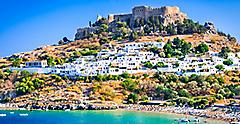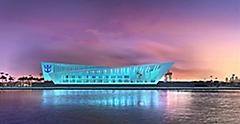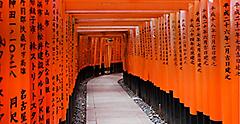
When it comes to Turkey travel, Istanbul is only the beginning.
When it comes to planning your Turkey travel, you may be looking forward to discovering the nooks and crannies of the Hagia Sophia Church in Istanbul or looking down on the impressive rock formations of Cappadocia from inside a hot air balloon. In fact, there's even more to discover: Turkey has a huge array of destinations, from the crystalline waters on its west coast to otherworldly hot springs formations near the country's eastern frontier. Here are the 10 best places to visit in Turkey, with something for every traveler.
1. ISTANBUL
For many travelers, Turkey is synonymous with Istanbul, the country's largest city (but not, to the surprise of some, its capital). Set on opposite sides of the Bosphorus Strait, which separates Europe from Asia, Istanbul is the epitome of "East Meets West." You can spend the morning in Europe touring the iconic Blue Mosque or feeding seagulls along the Golden Horn, then watch the sun set in Asia over a Turkish coffee. One amazing place to head any time of day is the Grand Bazaar, which is one of the largest covered markets in the world with its more than 4,000 shops.
Keep in mind that Istanbul is where most Turkey travel starts not only because of what an amazing destination it is, but because of logistical reasons: The city's two airports are the largest transport hubs in Turkey, and many cruise ships call in the city as well. Furthermore, it's also possible to travel to Istanbul from mainland Europe via an updated version of the historic Orient Express train. Regardless of how you get to Istanbul, the city is the perfect place to relax with a timeless Turkish hammam bath experience!
2. CAPPADOCIA
If you've ever seen an image of colorful hot air balloons floating over magical-looking mountains (probably capped with snow), there's a good chance you were looking at a picture of Cappadocia, Turkey. Located in the central part of the country not far from the holy city of Konya (where the famous Sufi poet Rumi was born), Cappadocia has long been a wonderland of mystical landscapes, although the introduction of mass global tourism is a more recent phenomenon.
Obviously, if you come here, flying a hot air balloon over the town of Göreme at sunrise (or, if you're afraid of heights, watching the balloons from down in the city) should be near the top of your bucket list. Another priceless experience that draws travelers from all around the world to Cappadocia is the opportunity to sleep within the towering rock formations in cave hotels that are not only surprisingly luxurious but are also naturally climate-controlled!
3. EPHESUS
Ephesus is a popular spot on Turkey tours these days, but the city (or at least, the ruins of the ancient city that once dominated this stretch of coastline) is unmistakably Greek. It's no wonder that the nearby port city of Kusadasi has become a popular destination for cruise ships, whose passengers flock here to take in countless examples of priceless world heritage.
Among these sights is the ancient Greek Theatre, an architectural marvel whose 24,000-person capacity is amazing even by today's standards, to say nothing of when it was built more than two millennia ago. The Temple of Hadrian, meanwhile, provides a window into ancient Greek spirituality, while a visit to the Terrace Houses allows you to get an idea of how wealthy Roman conquerors lived in the city after the Greek rulers surrendered to them. If you've seen Pompeii, you'll find this area very similar.
4. PAMUKKALE
If you aren't yet convinced that Turkey is like something out of a fairy tale, stop by Pamukkale. A series of terraced hot springs with pure white walls and turquoise water, Pamukkale literally means "Cotton Castle" in the Turkish language, and it more than lives up to its native name. Dive into the sparkling water for an experience like no other.
In addition to the Cotton Castle itself, the area around Pamukkale is home to historical structures. For example, you'll find Hierapolis, a 12,000-seat Roman amphitheater, just a few miles away. Denizli's airport is the gateway to this area of Turkey, and it also has several museums that explain local history. It's here that you can find a historical home where modern Turkey's first leader, Ataturk, spent some time.
5. IZMIR
Formerly known as Smyrna and with a history that includes long periods of rule by both Greeks and Romans, Izmir is one of Turkey's cultural hubs. Upon arriving in this ancient, far western city, you should climb Mount Kadifekale, where you can look down at the center of Izmir and stroll amid a rebuilt citadel. Kemeralti Carsisi is an ancient bazaar which has traditional handicrafts and souvenirs. One of Turkey's most beautiful synagogues is located within its lively alleyways.
Other treasures of Izmir are more recent, including the iconic Izmir Clock Tower, which only dates back to 1901 — practically new, as far as this city is concerned. Hisar Mosque, meanwhile, transports you back to the 16th century when Ottoman Turks first began asserting their control over the area.
6. VAN
Van is farther away than many of Turkey's famous sights but it's worth seeking out. Much of the architecture and culture here is similar to that of Armenia because of the city's proximity to that country. This influence can be seen in the 10th-century Akdamar Church, an Orthodox Cathedral that would not look out of place over the border at Lake Sevan.
Many of the other attractions of Van are even older than Akdamar Church. Van Castle, for example, is believed to date back as far as the 9th century, when the long-forgotten Urartu Kingdom ruled over a land that was centuries from becoming anything resembling modern Turkey. The Muradiye Selalesi waterfall, on the other hand, likely dates back millions of years and has no doubt been a source of tranquility for people on all sides of the many conflicts that have taken place near Van.
7. SANLIURFA
Often shortened to "Urfa," Sanliurfa is a small and relatively conservative city located in southern Turkey near the border with Syria. Although Urfa has become a tourist destination only recently, it's long been a pilgrimage site, as it's reputed to be the birthplace of Abraham. Pilgrims of several religions come here to walk the aptly-named "Abraham's Path," a set of routes said to resemble ones the prophet himself walked thousands of years ago.
Whether or not its history and legends appeal to you, Urfa is still a worthy addition to your Turkey travel. The Balikligol mosque, housed within the "Cave of Abraham" complex, is stunning, rising above a fish-filled turquoise pond. Come early in the morning to see its reflection in the still water.
You can also explore the ruins of the 8th-century Urfa Castle and practice your bargaining skills in the traditional bazaar, which is smaller than Istanbul's but still home to countless potential souvenirs.
8. ANKARA
Ankara, a city in the center of the country, became the capital in 1923 when the Turkish Republic was born after the centuries-old Ottoman Empire finally collapsed. While Ankara's tenure as the Turkish capital began relatively recently, many of the attractions in and around the city are just as old as those elsewhere in Turkey.
Ankara Castle, for example, dates back to an unknown year in the early medieval period, sometime after the Romans arrived in what was then known as Anatolia but before the Byzantines conquered it. If you have a deeper interest in Anatolia (the name by which this region of Turkey is still technically known), you can also visit the Museum of Anatolian Civilizations, which is located right beneath the castle and dives further into each of the cultures that has taken root at this historical crossroads.
9. TRABZON
Trabzon is a great place to base yourself as you explore the area. It's a tranquil and beautiful city where the minarets of whitewashed mosques rise above emerald hills and sapphire lakes. The fresh cherries grown in the surrounding countryside are as much of a staple as pan-Turkish favorites like döner kebab sandwiches.
Within the city, you can visit the Hagia Sophia Church which, while not to be confused with Istanbul's, also bears a similar history, having been a church before it became a museum, after which it became a mosque. If you have more than one day in the city, use the second to make an excursion to the cliff-hewn Sumela Monastery, whose stunning Greek frescoes date back to the fourth century.
10. ANTALYA
Turkey has thousands of miles of coastline and so is home to many gorgeous beaches. However, if you're looking for the most beautiful ones, you'll want to head southeast to Antalya, which is not only a historical city with architecture and artifacts dating back to the time of the Romans but a gateway to the gorgeous coastal province of the same name.
In addition to the city, much of what has made Antalya such a staple of Turkey travel is the otherworldly stretches of shoreline in more rural spots. Top Antalya beaches include Cirali Beach, where white sands and clear waters juxtapose ancient ruins, and Alanya Dogu Beach, whose pristine coastline is more than 25 miles long. If you have longer than a few days along Turkey's coast, continue heading west to Fetihye, where the enchanting Blue Lagoon of Oludeniz awaits.
No matter what you hope to do on your vacation, the amazing sights and culture make Turkey a perfect destination for your next trip.


















